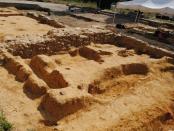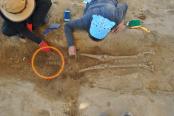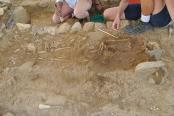CAMPAGNA 2018 |
1° SETTIMANA |
2° SETTIMANA |
3° SETTIMANA |
4° SETTIMANA |
5° SETTIMANA |
6° SETTIMANA |
7° SETTIMANA |
8° SETTIMANA |
9° SETTIMANA |
04 LUGLIO 2018 
Resoconto della giornata di scavo
Area 3000
La pulizia della porzione settentrionale del Settore B ha messo in evidenza i resti dei tagli di due fosse sepolcrali inerenti alle fasi cimiteriali di XI secolo (US – 3908 e US – 3920), i cui riempimenti (US 3909 e 3921) sono intercettati da altre tombe successive appartenenti alla stessa fase. In particolare US – 3908 è orientata W-E, è collocata a ridosso della facciata settentrionale USM 3335 e sembra tagliare, immediatamente a sud, parte del riempimento della buca semicircolare US – 3910. Il riempimento US 3921 di US – 3920, invece è intercettato a nord dalla tomba US – 3860 e a sud dal condotto di alimentazione della fornace per la campana US – 3623. Nella porzione meridionale è iniziato l’abbassamento generale del settore, così come era stato fatto a nord, con lo scopo di completare l’indagine dei livelli cimiteriali di XI secolo e raggiungere le fasi di frequentazione più antiche del sito.
Today at the site we cleaned and scratched the entirety of section B. After that we hosed down the site and started to dig in areas through the northeast area of section B in places where there were potential changes in soil color.
Three cuts and fills on the south side were excavated. These consisted of one empty grave and two holes, one of which is potentially a grave marker. Contact sheets were filled out for these and measurements as well as photographs were taken.
Area 5000
E' stato completato lo scavo delle nuove sepolture messe in luce nei giorni precedenti. Lo stato di conservazione delle ossa unito alle attività successive di costruzione degli edifici abbaziali che hanno intercettato e asportato parte degli individui inumati ci hanno permesso solo di stabilire l'orientamento Ovest-Est delle sepolture, perfettamente in accordo con le tombe già individuate nell'area nelle precedenti stagioni di scavo. Nei prossimi giorni ci dedicheremo all'esplorazione degli strati più antichi della porzione meridionale dell'area così da poter completare l'indagine stratigrafica di questa porzione del sito.
Today the students continued working on the cranium eventually removing it from the hole. After the cranium was removed, we attempted to expose more of the bones left in the southern hole but they were so fragile that they were crumbling away as they were being exposed. With the careful use of a trowel, larger fragments of bone were able to be unearthed without first disintegrating and the bottom of the hole was reached. The students not working in the holes cleaned the entire area of sections B and C and began cleaning section D as well.
Area 6000
La messa in luce della sepoltura USk 6220, sul lato occidentale dell'area, ha permesso di evidenziare come tale individuo sia stato intercettato e tagliato (a livello delle vertebre lombari) da una deposizione successiva. USk 6220 risultava già, a sua volta, aver tagliato una sepoltura più antica, USk 6219. Sul lato orientale del settore sud prosegue l'esposizione dell'individuo USk 6218, sepoltura ricavata nello spazio di risulta tra le tombe a cassa UUSSMM 6062, 6194 e 3047. Nell'angolo nord-est, infine, ciò che rimane di due arti inferiori in connessione testimoniano l'azione di taglio concomitante alla costruzione della tomba a cassa USM 6062 che ha asportato il resto dello scheletro.
Today in 6217 we continued to excavate down to the level of the feet and found the tibias, fibulas, and the femurs that were cut and moved during the digging of a later burial. There was also part of a pelvis under the femurs. This burial was given the number 6225. Just north of the tib/fib/femurs, a skull was discovered to be in an exploded condition, and excavation of this cranium began.
In burial 6221, we continued to expose the remains of the complete burial and any remains associated with the reductions around the intact skeleton. There was also a large clump of vertically positioned stones around the burial, which is unusually, so we also worked on exposing but not removing these stones in order to examine any possible pattern to them. In addition, a small green metal object was found in this area. It has been speculated that the object is a clasp for a necklace.
Today was an interesting day for area 6222… We starting leveling the ground around the legs, uncovering the left fibula. Then, two of us began uncovering the upper west portion of the fill. In doing so, we found the entire lumbar portion of the vertebral column, which included an almost fully intact sacrum, and two iliums. Tomorrow, we will begin uncovering more to see if there is a full os coxae present. We have also uncovered a right arm bone (unidentifiable). Unfortunately, the vertebral column ends at the first lumbar vertebra (since there were clearly five in order from the sacrum up. Thus far, this is said to be the most well preserved bones in area 6000, though incomplete from the lumbar vertebrae upwards. Pottery fragments were also found, one of what was thin and made of pure clay, and likely belonged to a small cup or dish, while the other was larger and thick with a rough consistency and thought to be a bowl or pot used for cooking or holding large meals.














